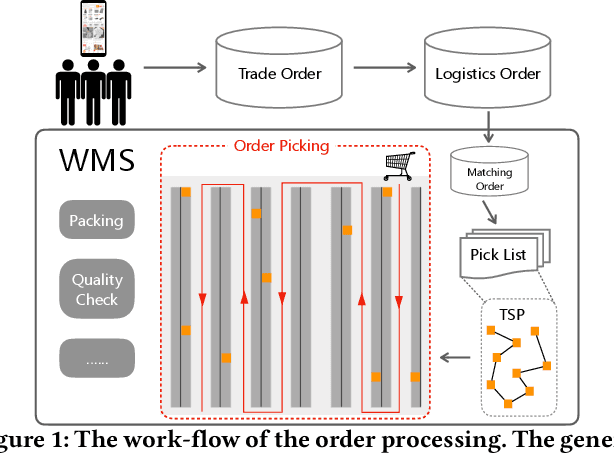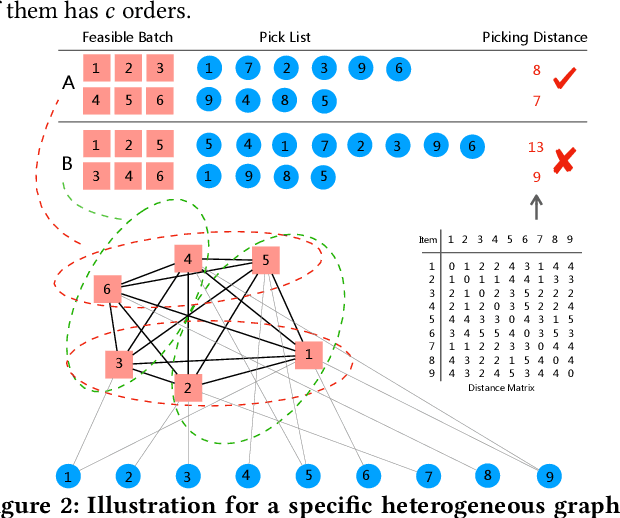Lu Duan
Balanced Order Batching with Task-Oriented Graph Clustering
Aug 19, 2020



Abstract:Balanced order batching problem (BOBP) arises from the process of warehouse picking in Cainiao, the largest logistics platform in China. Batching orders together in the picking process to form a single picking route, reduces travel distance. The reason for its importance is that order picking is a labor intensive process and, by using good batching methods, substantial savings can be obtained. The BOBP is a NP-hard combinational optimization problem and designing a good problem-specific heuristic under the quasi-real-time system response requirement is non-trivial. In this paper, rather than designing heuristics, we propose an end-to-end learning and optimization framework named Balanced Task-orientated Graph Clustering Network (BTOGCN) to solve the BOBP by reducing it to balanced graph clustering optimization problem. In BTOGCN, a task-oriented estimator network is introduced to guide the type-aware heterogeneous graph clustering networks to find a better clustering result related to the BOBP objective. Through comprehensive experiments on single-graph and multi-graphs, we show: 1) our balanced task-oriented graph clustering network can directly utilize the guidance of target signal and outperforms the two-stage deep embedding and deep clustering method; 2) our method obtains an average 4.57m and 0.13m picking distance ("m" is the abbreviation of the meter (the SI base unit of length)) reduction than the expert-designed algorithm on single and multi-graph set and has a good generalization ability to apply in practical scenario.
Exact-K Recommendation via Maximal Clique Optimization
May 17, 2019



Abstract:This paper targets to a novel but practical recommendation problem named exact-K recommendation. It is different from traditional top-K recommendation, as it focuses more on (constrained) combinatorial optimization which will optimize to recommend a whole set of K items called card, rather than ranking optimization which assumes that "better" items should be put into top positions. Thus we take the first step to give a formal problem definition, and innovatively reduce it to Maximum Clique Optimization based on graph. To tackle this specific combinatorial optimization problem which is NP-hard, we propose Graph Attention Networks (GAttN) with a Multi-head Self-attention encoder and a decoder with attention mechanism. It can end-to-end learn the joint distribution of the K items and generate an optimal card rather than rank individual items by prediction scores. Then we propose Reinforcement Learning from Demonstrations (RLfD) which combines the advantages in behavior cloning and reinforcement learning, making it sufficient- and-efficient to train the model. Extensive experiments on three datasets demonstrate the effectiveness of our proposed GAttN with RLfD method, it outperforms several strong baselines with a relative improvement of 7.7% and 4.7% on average in Precision and Hit Ratio respectively, and achieves state-of-the-art (SOTA) performance for the exact-K recommendation problem.
Automatic Generation of Chinese Short Product Titles for Mobile Display
Nov 05, 2018



Abstract:This paper studies the problem of automatically extracting a short title from a manually written longer description of E-commerce products for display on mobile devices. It is a new extractive summarization problem on short text inputs, for which we propose a feature-enriched network model, combining three different categories of features in parallel. Experimental results show that our framework significantly outperforms several baselines by a substantial gain of 4.5%. Moreover, we produce an extractive summarization dataset for E-commerce short texts and will release it to the research community.
A Multi-task Selected Learning Approach for Solving New Type 3D Bin Packing Problem
Aug 09, 2018



Abstract:This paper studies a new type of 3D bin packing problem (BPP), in which a number of cuboid-shaped items must be put into a bin one by one orthogonally. The objective is to find a way to place these items that can minimize the surface area of the bin. This problem is based on the fact that there is no fixed-sized bin in many real business scenarios and the cost of a bin is proportional to its surface area. Based on previous research on 3D BPP, the surface area is determined by the sequence, spatial locations and orientations of items. It is a new NP-hard combinatorial optimization problem on unfixed-sized bin packing, for which we propose a multi-task framework based on Selected Learning, generating the sequence and orientations of items packed into the bin simultaneously. During training steps, Selected Learning chooses one of loss functions derived from Deep Reinforcement Learning and Supervised Learning corresponding to the training procedure. Numerical results show that the method proposed significantly outperforms Lego baselines by a substantial gain of 7.52%. Moreover, we produce large scale 3D Bin Packing order data set for studying bin packing problems and will release it to the research community.
 Add to Chrome
Add to Chrome Add to Firefox
Add to Firefox Add to Edge
Add to Edge